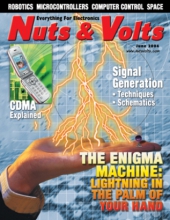Nuts and Volts Magazine
Features
The inspiration for this idea came from my students. Teaching DSP is difficult because you must slog through a fair amount of math before getting useful results. I noticed that, during my lecture on Z transforms, most students had donned their Walkmans/MP3 players. Their eyes were rolling. I needed drastic measures to turn this around. So, why not use the students’ love of music as a tool for teaching DSP? (Yes, I loved the movie The School of Rock.)
Most of the books and technical papers that describe digital filtering consist mostly of complex mathematical concepts with little to no emphasis placed on the practical implementation of a physical digital filter. The math behind digital filtering techniques is indeed interesting, but you don’t have to be a mathematician to design and build a working digital filter. Keep reading and I’ll prove it to you.
Projects
A sine wave signal generator can be used to measure the frequency response of filters and amplifiers. Simply connect the signal generator to the input of the circuit under test and adjust the output of the generator to an appropriate amplitude. Next, measure the output voltage of the circuit at various frequencies with an oscilloscope. A frequency response graph can then be plotted with this data.
The output frequencies from audio signal generators are not always either stable or accurately specified. An alternative is Direct Digital Synthesis (DDS). This process creates the desired output from numerical samples and generates any frequency you set with crystal accuracy.
This is one of those things that seems just a little interesting at the start, but, as you look closer, it gets stranger and stranger. It’s a simple, plain, plastic box. It has a knob, LED, and power connector. When you turn it on, it doesn’t seem to do anything at all. It just sits there. However, put an empty soda can on the machine and lightly rub it with a dry finger. The can vibrates. Yet, this does not happen with a stationary finger or a damp finger.
Columns
In The Trenches
by Gerard Fonte
IN THE TRENCHES
This month, we'll apply basic probabilities. We'll start by looking at some fundamental concepts and the mechanics of probabilities.
Near Space
by L. Paul Verhage
NEAR SPACE
There are several data loggers that are capable of fitting inside a lunch bag. By carrying one of these on the mission, you can collect additional science and engineering data. Since the data loggers collect data at a fixed rate (you program this rate into the data logger), you can relate the recorded data to the altitude of the near spacecraft.
Open Communication
by Louis E. Frenzel
OPEN COMMUNICATION
Despite the fact that spread spectrum (SS) technology is very widely used in every day wireless applications, few people — including technical types — actually know how it or its CDMA derivative works. It is one of the more complex wireless methods, but it has some really great benefits. With over 70% of US cell phones using this method, chances are you use a CDMA cell phone. Here is an introduction to this killer wireless technology.
Personal Robotics
by L. Paul Verhage
PERSONAL ROBOTICS
Often, we need our robot to make or break a circuit. This lets our robot operate a sensor, emit a warning tone, or even fire photon torpedoes. While we humans are really great at pushing buttons, robots have a problem because they tend to lack fingers and opposable thumbs. So just how do robots turn on and off circuits?
Q&A
by TJ Byers
Q&A
In this column, I answer questions about all aspects of electronics, including computer hardware, software, circuits, electronic theory, troubleshooting, and anything else of interest to the hobbyist.
Stamp Applications
by Jon Williams
STAMP APPLICATIONS
Like most men, I’m not real big on the idea of shopping. I know what I want. I want what I want. I know where to go get it — and that’s precisely what I do: I go get it. Of course, for every rule there is an exception and, for my shopping rule, there are two: book stores and Tanner Electronics in Dallas, TX. I love going to Tanner — even when I don’t need anything specific...
TechKnowledgey
by Jeff Eckert
TECHKNOWLEDGEY 2004
Events, Advances, and News
Just for Starters
by Mark Balch
Starting A New Design — Part 1: Architecture And Implementation
In this first installment of a two part series, we’ll walk through a small project scenario to see how to go from concept through design.

